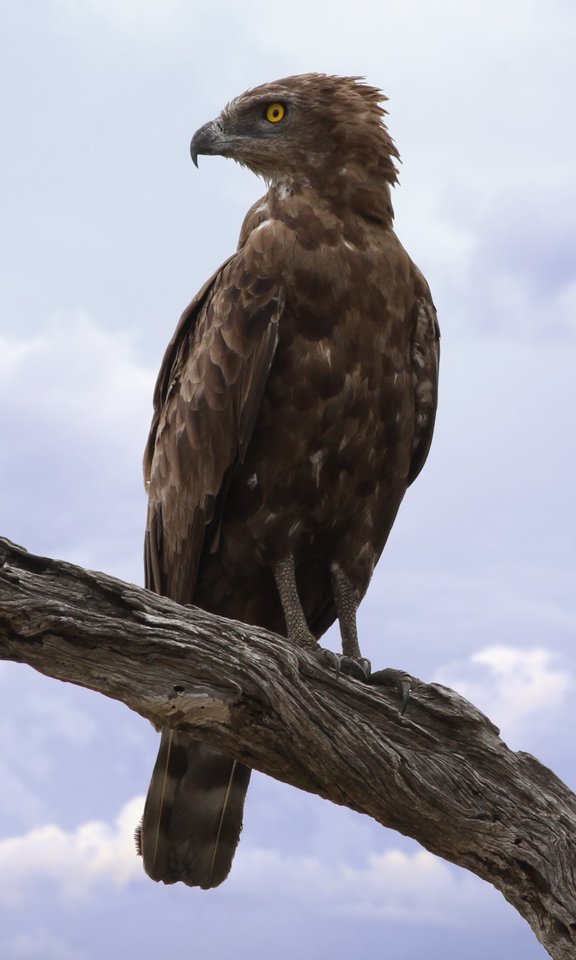The Brown Snake Eagle (Circaetus cinereus) is a large and fairly common species of snake eagle found in West, East, and southern Africa. Its uniform brown plumage, yellow eyes, black beak, and grey ceres and legs make it easily recognizable. The triangular edge on its head, created by the feathers on the top and back, is a distinctive feature that helps identify the bird when perched.
The Unique Feathers of the Brown Snake Eagle
The Brown Snake Eagle’s feathers are a key part of its adaptations for hunting and survival in its environment. Let’s take a closer look at the unique features of these feathers:
Barred Tail and Wings
The tail and wings of the Brown Snake Eagle are barred with alternating white and brown patterns. This camouflage helps the bird blend in with its surroundings while perched, making it harder for prey to detect.
Contrasting Underwing Patterns
The underwings of the Brown Snake Eagle are distinctive, with brown coverts and white flight feathers. This unique coloration helps the bird conceal itself from below while in flight, making it less visible to potential prey.
Protective Leg Feathers
The Brown Snake Eagle’s thick-skinned legs are protected by its feathers, which help shield the bird from the venomous bites of the snakes it hunts. This adaptation allows the eagle to safely capture and consume highly venomous snakes, a significant part of its diet.
Juvenile Plumage
Juvenile Brown Snake Eagles have a lighter coloration, sometimes appearing almost white with darker wings and backside. This plumage helps young birds blend in with their surroundings as they learn to hunt and survive on their own.
The Brown Snake Eagle’s Hunting Strategies
 Image source: Brown snake eagle By Derek Keats
Image source: Brown snake eagle By Derek Keats
The Brown Snake Eagle is a skilled and adaptable hunter, using a variety of strategies to catch its prey:
Perch Hunting
These eagles prefer to scan and hunt for prey from a perch, swooping down to catch their targets on the ground. This allows them to conserve energy and maintain a clear view of their surroundings.
Versatile Diet
While snakes make up the largest portion of the Brown Snake Eagle’s diet, they also hunt lizards, small mammals, and birds. This diverse food source helps the bird thrive in a variety of habitats.
Venomous Snake Hunting
The Brown Snake Eagle’s thick-skinned legs protect it from the bites of highly venomous snakes, allowing it to safely capture and consume these dangerous prey. However, the birds are not immune to the venom and have been known to be blinded by spitting cobras.
Nesting and Breeding Habits
The Brown Snake Eagle is a monogamous and solitary nester, with breeding seasons that vary depending on geographical location. Both male and female birds take part in building the nest, which is typically made of sticks and situated in the canopy of flat-topped trees.
Nest Reuse
Brown Snake Eagles often take over and fix deserted nests made by other birds of prey, such as the Tawny Eagle. This behavior helps the birds conserve energy and resources during the breeding season.
Egg Laying and Incubation
The female Brown Snake Eagle lays only one egg, which she incubates for 48-53 days. During the first ten days, she will brood the chick constantly, gradually reducing her time spent brooding as the chick grows older.
Chick Rearing
The male Brown Snake Eagle is responsible for providing food for the chick, which remains in the nest for 95-112 days before fledging. The young bird will only become fully independent a week to two months after leaving the nest.
Conservation Status and Habitat Preferences
The Brown Snake Eagle has a very wide distribution and is locally very common in certain areas with suitable habitat. It is currently listed as Least Concern on the IUCN Red List, with no perceived major threats at the moment.
Habitat Requirements
The Brown Snake Eagle prefers dry bushy and thorny landscapes, woodland savannas, and thorny scrublands. It avoids open grass plains and dense forests, preferring environments that provide ample perching opportunities and access to its preferred prey.
Adaptability
The Brown Snake Eagle’s ability to adapt to a variety of habitats and its resilience in the face of threats have contributed to its widespread distribution and healthy population status. Its unique feather adaptations and hunting strategies have allowed it to thrive in its African range.
References:
– Oiseaux-Birds.com – Brown Snake Eagle
– Wildlife Vagabond – Brown Snake Eagle
– Wikipedia – Brown Snake Eagle
– Eagle Encyclopedia – Brown Snake Eagle

